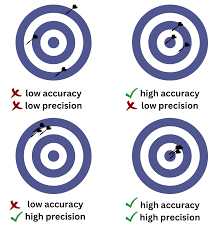The Difference Between High Precision and Low Accuracy
When it comes to measurements and data analysis, the terms “precision” and “accuracy” are often used interchangeably. However, these two concepts have distinct meanings that are crucial to understand, especially in scientific and technical fields.
High Precision:
Precision refers to the level of consistency and reproducibility in repeated measurements. A measurement is considered highly precise if repeated trials yield very similar results. In other words, high precision indicates that the data points are clustered closely together.
For example, imagine a target with multiple arrows hitting very close to each other but slightly off-center. While the arrows may not be hitting the bullseye (accuracy), their proximity to each other demonstrates high precision.
Low Accuracy:
In contrast, accuracy relates to how close a measured value is to the true or accepted value. A measurement is accurate if it is close to the target or true value. Low accuracy means that there is a significant deviation between the measured values and the actual value being targeted.
Continuing with our archery analogy, if multiple arrows consistently hit the same spot on a target but far from the bullseye, they are accurate but lack precision due to their inconsistency in hitting closer together.
Implications:
Understanding the difference between high precision and low accuracy is vital in various fields such as engineering, manufacturing, medicine, and research. High precision ensures reliable and consistent results within a set of measurements, while accuracy guarantees that those results are close to reality.
In practical applications, striking a balance between high precision and high accuracy is often desired but challenging. It requires careful calibration of instruments, meticulous data collection methods, and thorough analysis techniques.
Understanding High Precision and Low Accuracy: Key Questions Answered
- What is the difference between high precision and low accuracy?
- How can high precision be achieved with low accuracy?
- What are the implications of high precision but low accuracy in scientific experiments?
- Can you provide examples of situations where high precision and low accuracy are observed?
- What strategies can be employed to improve both precision and accuracy in measurements?
What is the difference between high precision and low accuracy?
The distinction between high precision and low accuracy lies in the consistency and closeness of measurements to each other versus their proximity to the true or target value, respectively. High precision signifies that repeated measurements yield very similar results, indicating consistency and reproducibility. On the other hand, low accuracy suggests a significant deviation between measured values and the actual value being targeted. While high precision ensures data points are clustered closely together, accuracy ensures that those points are close to the true value. Striking a balance between these two factors is crucial in various fields to achieve reliable and meaningful results.
How can high precision be achieved with low accuracy?
Achieving high precision with low accuracy is a common challenge that arises in various scientific and technical disciplines. One way to accomplish this is by ensuring that measurements are consistently reproducible and tightly clustered together, demonstrating high precision. While the individual data points may not be close to the true value (low accuracy), their consistency and repeatability contribute to achieving high precision. By focusing on reducing random errors, improving calibration techniques, and enhancing measurement procedures, it is possible to enhance precision even in cases where accuracy may be compromised. Striking a balance between precision and accuracy requires careful consideration of the specific requirements of the task at hand and implementing strategies to optimise measurement processes accordingly.
What are the implications of high precision but low accuracy in scientific experiments?
In scientific experiments, the implications of high precision but low accuracy can be significant. While high precision ensures consistency and reproducibility in measurements, low accuracy means that the results are consistently off-target from the true value. This discrepancy can lead to misleading conclusions and erroneous interpretations of data. Researchers may face challenges in making reliable predictions or drawing valid scientific conclusions when dealing with high precision but low accuracy. It is crucial to understand and address this discrepancy to avoid potential misinterpretations and ensure the credibility and integrity of scientific findings.
Can you provide examples of situations where high precision and low accuracy are observed?
In certain scenarios, instances of high precision and low accuracy can be observed simultaneously. One common example is a clock that consistently runs fast or slow by the same amount each day. While the clock’s readings may be precise in terms of consistency (high precision), they are inaccurate as they deviate from the correct time (low accuracy). Another instance could be a weighing scale that consistently shows a weight that is slightly off from the actual weight due to a calibration error. These examples highlight how high precision and low accuracy can coexist, emphasising the importance of considering both factors when evaluating measurements and data.
What strategies can be employed to improve both precision and accuracy in measurements?
To enhance both precision and accuracy in measurements, several strategies can be implemented. Firstly, calibrating instruments regularly and ensuring their accuracy against known standards is crucial. Additionally, employing proper measurement techniques, such as taking multiple readings and averaging them, can improve precision. Using high-quality equipment and maintaining a controlled environment to reduce external factors that could affect measurements is also essential. Furthermore, conducting thorough training for personnel involved in data collection and analysis can minimise human errors and enhance overall accuracy. By combining these strategies and continuously monitoring and adjusting processes, it is possible to achieve higher levels of both precision and accuracy in measurements.

